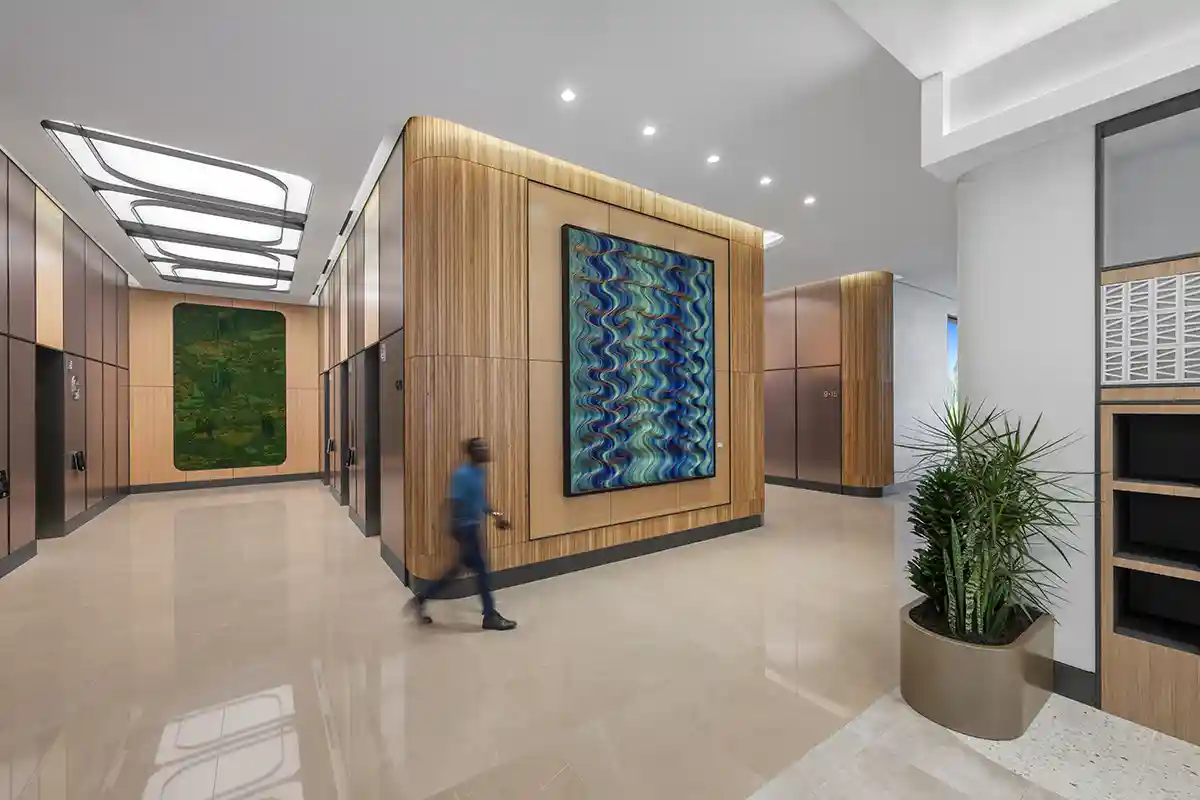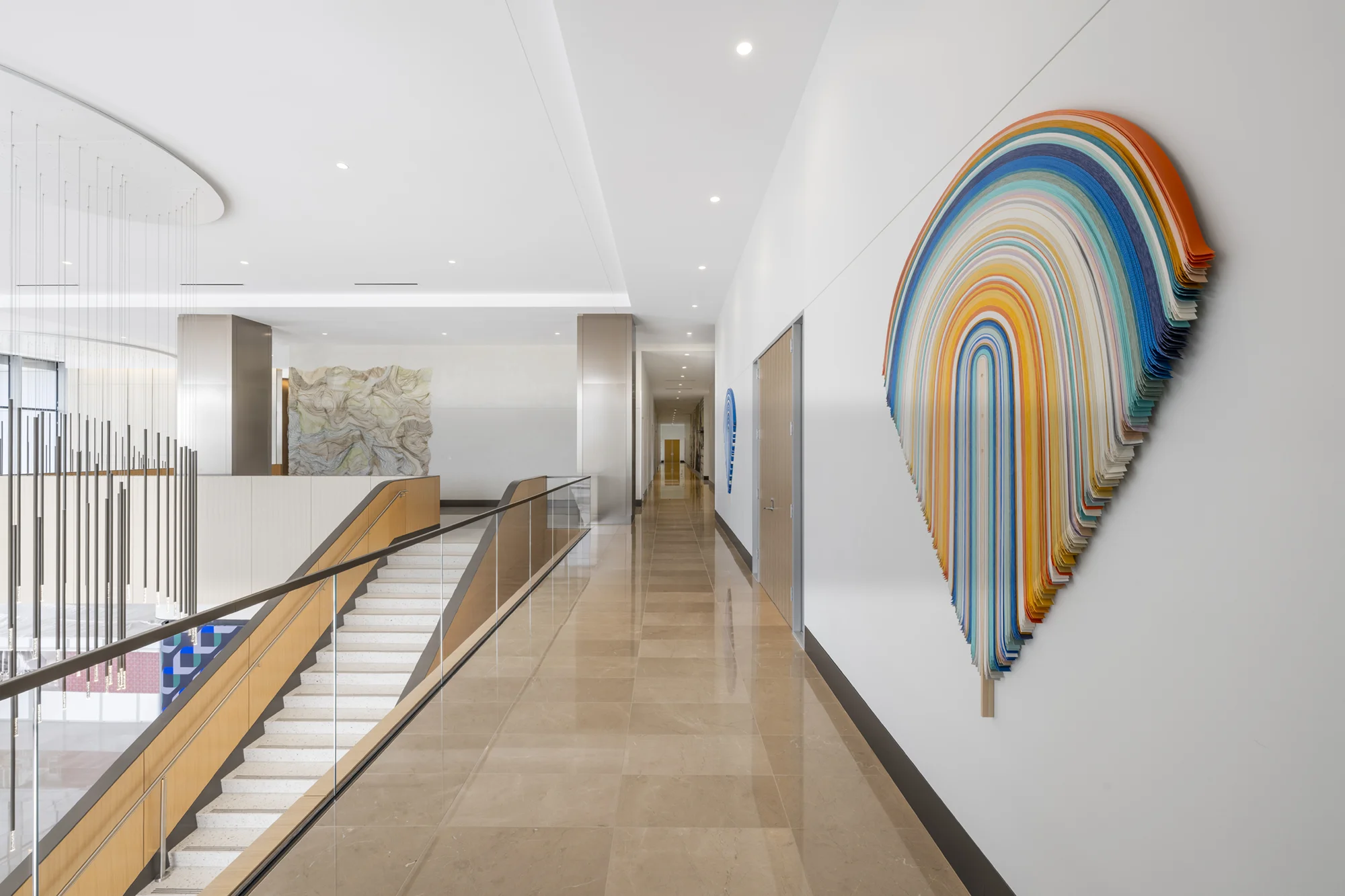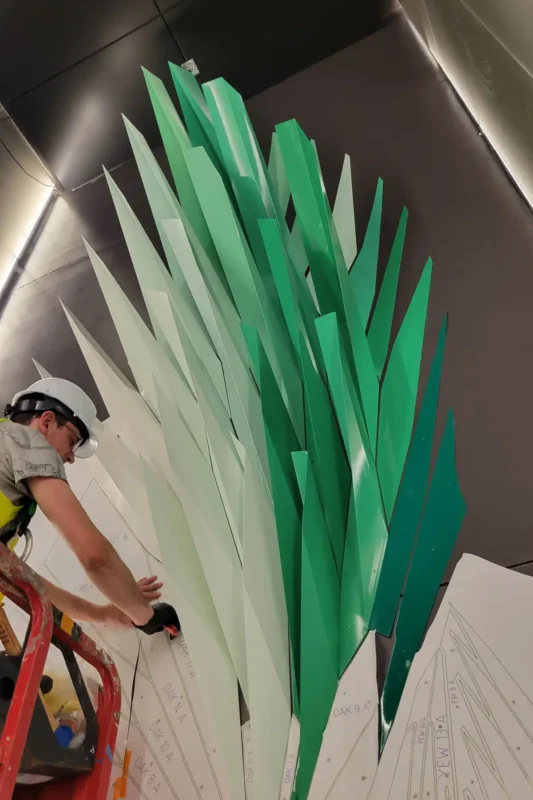How do you properly and safely install and display art at an office or commercial property? As you might guess, there are numerous logistics involved. Architectural design considerations, permitting, and loading dock coordination are just a few of the details to be managed.
Without someone overseeing the entire project—someone who has an expert understanding of the interplay between art and architecture, design and construction—you can end up making mistakes that require costly rebuilds.
As commercial art consultants, we’re experts at everything to do with art curation, procurement, and installation. Our project managers have experience, training and certifications in the worlds of art, interior design, and construction. In this article, we’ll share some of our expertise with you and you’ll learn about the most cost-effective approaches to installing art at your business or commercial property.
Architectural Design Constraints: What You’ll Wish You Knew
Many people are surprised to learn that the ideal time to begin planning your art installation and display is during the early phases of your building’s architectural design. By starting early, you can avoid many potential issues and enable your teams to work more seamlessly.

Photo: A metal triptych installed at a financial services client office.
Material Incompatibility
Some materials used in building construction can react negatively with some art materials. For example, walls made with certain types of wood, especially chemically treated wood, can cause certain kinds of metal to corrode over time. Artwork created with acidic media or stored in an environment where acid precipitation can occur might cause damage to surfaces like marble or limestone. A qualified commercial art consultant can review your building plans and advise you on which kinds of art will work with your specified materials. They can also assess your plans for any potential humidity and environmental factors that can negatively affect your art.
No Digital Connection for Interactive Art Displays
Interactive art utilizes digital technology to gather datasets and turn them into dynamic and personalized art experiences. Of course, they require digital connections and electrical outlets placed in the right area. A qualified commercial art consultant can coordinate between the artist and the construction teams to run the proper conduits and ensure digital artwork thrives.
Video: Art + Artisans project managers helped coordinate conduit placement for this interactive sculpture at TIAA with 570 custom programmed LEDs integrated into each of its tubes.
The Wrong Lighting for an Art Display
When lighting is needed to showcase art or is part of the artwork itself, a commercial art consultant has the expertise to ensure the best lighting is selected for the piece.
Structures Not in Place to Support Large Artwork
When installing and displaying large-scale art in a commercial building, adequate wall structure and support, secure hanging systems, and building codes and safety regulations must all be considered. A qualified commercial art consultant can work with your architectural and construction teams to solve for these details, always ensuring that the size and placement of the art enhances the building architecture and the design of the surrounding space.
Failure to Obtain Permits for Installation of Outdoor Art
Even if you’re installing art on private property, municipal permits might still be required. For example, if you plan to install a large outdoor sculpture, the city will likely require you to submit plans and specifications to demonstrate it adheres to public safety and environmental regulations. Likewise, if installing a large outdoor mural requires blocking public access to the sidewalk or street in front of your building, you’ll need a permit from the city. Qualified commercial art consultants can quickly evaluate whether any part of your art package is likely to require permitting. In these cases, the art consultants at Art + Artisans coordinate with contractors and city officials to oversee the permitting process and ensure all necessary paperwork is pulled.
Failure to Adhere to Art Installation Specs During Building Construction
Not adhering to art display specifications during construction can result in damage to your artwork, rework costs, project delays and scheduling issues, safety hazards, and more. A+A project managers coordinate with your general contractor and visit your construction site to ensure all installation specs have been adhered to and that everything is up to code.

Image: Art + Artisans worked with TIAA’s team to ensure the proper support systems were in place to display this 500-lb. artwork at their new North Texas offices.
Onsite Art Delivery: Did Anyone Book the Freight Elevator?
A disorganized approach to receiving artwork deliveries at your building site can lead to injuries, property damage, delays in installation, and disruptions to the overall construction schedule. Your Art + Artisans project manager will oversee the entire artwork delivery process to avoid these issues. The following are some of the details we oversee.
Coordinating with the General Contractor and Other Trades
Communication is the key to coordination and safety on a construction site. Your art consultant should be in regular communication with your GC or site manager and the other trades to avoid scheduling conflicts that can cause safety issues or delays to the project. Art + Artisans project managers are well-versed in construction processes and maintain regular communication with others working on site to let them know about the scope, schedule and methods we use.
Booking of Specialized Fine Art Delivery Service
While using a regular delivery service for your new art might be tempting, the potential costs and delays are not worth the risk. Regular shippers use inadequate packing materials for delicate artwork. They’re not trained in art handling which is a specialized skill. Their vehicles and storage are not equipped with environmental controls necessary for safe transport of art. And their standard insurance likely won’t cover the full cost of a valuable piece of art. Specialized fine art delivery services have the expertise, equipment, and insurance necessary for the safe and secure transport of your valuable artwork.
Gallery: Expert art handlers, hired by Art + Artisans, transport and install a historical, Japanese samurai warrior garment for our clients at TEL.
Designating a Staging Area at the Building Site
Construction sites are dusty, busy places. Without a designated staging area on-site for the unpacking and inspection of your art, you risk damage to the artwork from dust and debris, physical impact, or improper handling. You also increase the chances of theft when you don’t designate a secure area for storing the art. A qualified commercial art consultant manages and oversees these details so that every piece of your art package is accounted for and stored in a secure area until you’re ready to install.
Overseeing Unpacking of Art and Inspecting it for Any Damage
The art consultants at Art + Artisans perform on-site supervision of art unpacking, ensuring it’s done in a safe, designated staging area and that proper tools and handling are used. They inspect the art for any damage that might have occurred in transit, using proper lighting and documenting the condition of the piece on arrival with photographs.
Promptly Arranging for the Correction of Any Issues.
If there are any issues with the artwork upon arrival, Art + Artisans will promptly contact the seller or shipping company to remedy the situation.
Gallery: Professional art installers place painted aluminum pieces on a 20-ft. sculpture using the artist’s mapping template. Art + Artisans oversaw this complex installation for our clients at The QUAD, documenting it with photos. This is an especially crucial step in cases where the artist isn’t present.
Commercial Art Installation: What Could Go Wrong?
Art installation, like art transport and delivery, is a specialized skill. Improper mounting, placement, or handling of art can result in damage to the art, the building surfaces, or the building structure in the case of very large statement pieces. Art that isn’t properly secured can fall and cause injuries to workers, employees and visitors. Not to mention, it can result in a substandard display.
To avoid costly errors and delays, we always work with an art installation specialist. We oversee the art installation and direct the specialist on the exact height and placement for each piece, documenting everything with photographs.
Final Walk Throughs: A Checklist
After the artwork is installed, it’s imperative that you do a walk through to assess the completed work and address any outstanding issues. The following art installation checklist can be helpful.
- All artwork is placed according to project specifications.
- All art is in pristine condition.
- Correct art display lighting is in place.
- Electrical and data connections are properly placed and in working order.
- Art display areas are in pristine condition.
A qualified commercial art consultant will conduct the walkthrough with you, referencing the project specifications and floorplan. If the final construction of the property differs from the floorplan, the art consultant should show you any display areas that were changed as a result. If there are any needed changes following the walkthrough, your art consultant should organize a prompt resolution. If you are satisfied with everything at the final walkthrough, you can sign off on the placement and the installation process is complete.
Conclusion
Planning for art installation from the very beginning of your building project can save you a lot of time and expense. Architects are experts at designing structures that reflect your organization’s needs. But they aren’t experts at art risk assessment. Our art consulting team is equally comfortable in the worlds of art, architecture, interior design, and construction. Bringing them in early means they can advise you on artwork installation before building construction begins, preventing costly mistakes.




